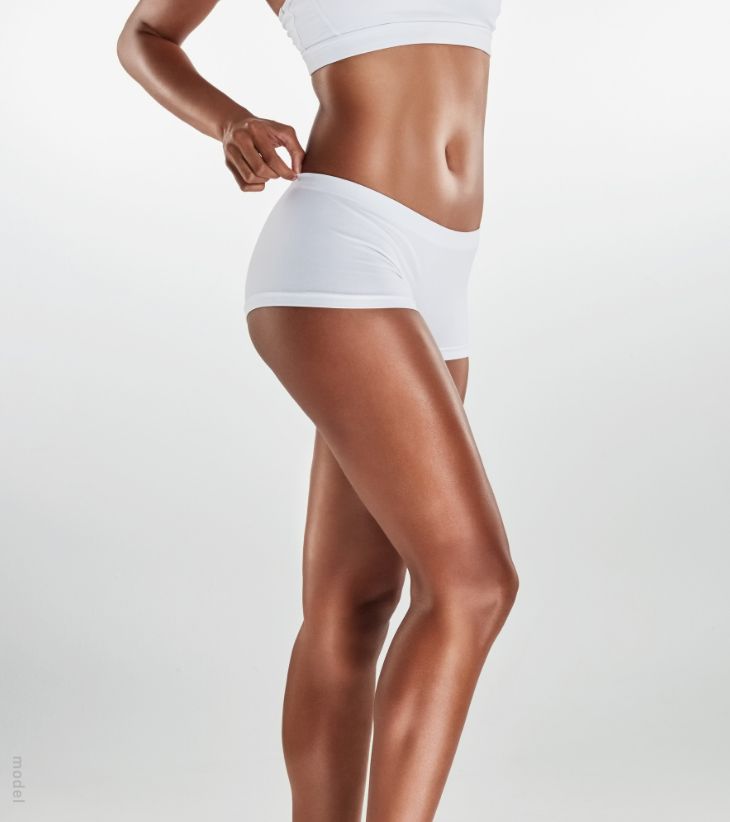Liposuction in New Orleans, LA
Everyone wants to look their best, but it can be frustrating battling the time demands of modern life, genetics, and aging. For many individuals, a healthy diet and regular exercise are simply not enough to eliminate stubborn, unwanted fat and cellulite. Dr. Kamran Khoobehi is an accomplished, board-certified plastic surgeon who provides advanced liposuction options in New Orleans for men and women seeking to remove pockets of fat and sculpt their bodies.
Plan Your Liposuction Procedure
Average Cost
$1,500 – $7,000
Recovery Time
1 Weeks
Average Procedure Time
30-60 Minutes per body part
View Photo Gallery Schedule A Consultation
What is Liposuction?
A minimally invasive surgery, liposuction is designed to remove pockets of fat from the body. It involves a medical vacuum attached to a thin tube called a cannula, which is used to suction away localized pockets of fat. Because liposuction is far less invasive than other body contouring surgeries like abdominoplasty and doesn’t require the downtime associated with more extensive surgery, this procedure has become one of the most popular cosmetic procedures in the world.
What Can Be Achieved With Liposuction?
Individuals who choose to undergo liposuction can expect the elimination of diet and exercise-resistant pockets of fat almost anywhere on the body, including:
- Chin
- NeckUpper Arms
- Back
- Waist
- Belly
- Lower Abdomen
- Hips
- Buttocks
- Thighs
- Knees
Depending on the extent of treatment desired, patients can address one or two problem areas or create an entirely new silhouette.
Am I a Candidate for Liposuction in New Orleans, LA?
Liposuction candidates should be:
- In good health
- Non-smokers
- At or near their ideal weight for at least six months
- Have realistic expectations for their results and a week or more to devote to recovery and healing
Why choose Dr. Kamran Khoobehi For Liposuction in New Orleans, LA?
You have many providers to choose from for liposuction in New Orleans. However, your safety and long-term results depend on choosing the right plastic surgeon.
Dr. Khoobehi is a highly-regarded plastic surgeon named one of Newsweek’s Top 50 Plastic Surgeons. His state-of-the-art techniques ensure customizable treatment for results that meet or exceed expectations. Our surgeon offers the following liposuction options:
Surgical Technique

Tumescent “Super-wet”
A suction-assisted (SAL) technique, tumescent liposuction uses a solution and power-aided motor to help remove stubborn fat. Dr. Khoobehi injects the solution, which is made of saline, lidocaine, and epinephrine (to control bleeding), into the problem areas. Dr. Khoobehi then inserts the cannula to remove fat cells from the body at a controlled speed.
Laser-assisted (Lal)
Laser-assisted liposuction uses laser technology on specified areas of fat to burst energy that will loosen and liquefy the fat for removal, along with tightening the superficial tissue. LAL liposuction includes brands such as SmartLipo or Bodytite.
These advanced techniques can shorten the procedure time, add tightening benefits, and often make recovery quicker and easier.
Call Dr. Kamran Khoobehi, our New Orleans liposuction specialist, at (504) 779-5538.
Before Liposuction
All liposuction patients will meet with Dr. Khoobehi for an in-depth consultation, at which time you will discuss your concerns, desired results, options, and risks. Our surgeon will review your medical history and ask about any medications you take and lifestyle habits.
At the end of your consultation, Dr. Khoobehi will make his recommendations, create a personalized treatment plan, and provide a cost estimate.
During Liposuction
Liposuction is performed on an outpatient basis under general anesthesia at our surgical center or with local anesthesia at Dr. Khoobehi’s accredited surgical suite. The procedure lasts about 30–60 minutes for each area and is offered as a stand-alone surgery or combined with other procedures.
Small incisions are made at the treatment site, the cannula is inserted under the skin, and the fat cells are loosened or liquified, using either the suction-assisted or laser-assisted method, then suctioned out of the body.
How Long Is Liposuction Recovery?
After surgery, patients must wear a compression garment to help the body adjust to its new shape. Most bruising and swelling will subside within one week, and initial changes are noticeable, but results won’t be final for several weeks.
Dr. Khoobehi recommends that endermologie (post-surgery massage) be completed at least five times after surgery, which helps induce circulation and reduce swelling.
Can I Combine Liposuction With Other Procedures?
Dr. Khoobehi also recommends combining liposuction with Morpheus8™ or BodyTite® during the surgery to help tighten the skin in the treated areas. The pairing of these procedures will assure a more ideal outcome.
Need Comprehensive Skin Tightening?
While liposuction removes fat and improves contour and shape, it does not address sagging or drooping skin. If skin laxity is a concern, Dr. Khoobehi will discuss options for correcting loose skin, such as a tummy tuck, lower body lift, arm lift, or butt lift.
Combination surgeries usually take between three and four hours to complete. In some cases, Dr. Khoobehi may suggest performing these surgeries over a period of time for the safety of the patient. Liposuction is commonly combined with cosmetic breast surgeries, including:
Combining cosmetic breast surgery with body contouring is often referred to as a Mommy Makeover.
When Will I See My Liposuction Results?
Smaller treatment areas may show final results in as little as three to four weeks, while larger areas can take as long as three to six months to complete their transformation.
Learn More About Your New Orleans Liposuction Options
To schedule your New Orleans, Louisiana, liposuction consultation with Dr. Kamran Khoobehi, call (504) 779-5538. Our board-certified plastic surgeon offers financing options with top medical financing companies and can work with you to help you achieve your aesthetic goals.
Our Financing Options:
Liposuction FAQs

How much does liposuction cost?
The average cost for liposuction depends on the technique and scope of the surgery. Most patients in the U.S. can pay anywhere from $1,500 to $7,000 for one procedure. If combined with other procedures, the cost of the surgery can increase significantly. Dr. Khoobehi is known for his expertise and personalized approach to Liposuction. He works closely with each patient to develop a treatment plan tailored to their specific needs and goals, ensuring they achieve the best possible outcome.
Is liposuction safe?
When performed properly, liposuction is a very safe procedure. It is important for patients to do their research and find an experienced surgeon, like Dr. Khoobehi, who can help them achieve the best, most natural-looking results.
Are liposuction results permanent?
The results of liposuction last for many years. The outcome can be permanent if the patient follows a healthy diet and exercise program. Fat cells removed by liposuction do not return, but remaining fat cells can still grow if excess calories are consumed.
How much fat can liposuction remove?
The American Society of Plastic Surgeons recommends limiting fat removal to 10 pounds during a single liposuction session. Removing more than this can increase the risk of complications. Patients should be at or near their ideal weight before undergoing this procedure.
Does liposuction leave scars?
Liposuction leaves a small scar but fades over time, often disappearing completely.
Making Your Dream Plastic Surgery Procedure a Reality
Dr. Khoobehi offers financing options with top medical financing companies. We work with you to help ensure you can achieve your desired cosmetic enhancements.
View Financing OptionsCosmetic and Medical Spa Located in the New Orleans Area
You are invited to learn more about the procedures offered by Dr. Khoobehi and to schedule your personal consultation at our plastic surgery office.
Schedule A Consultation
Contact Us
(504) 779-5538KHOOBEHI
3901 Veterans Blvd
Metairie, LA 70002
